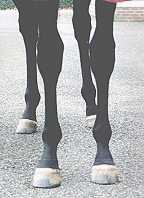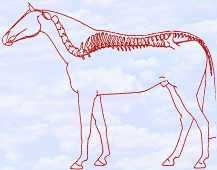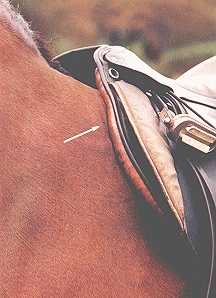![]()
 Horses
move!
Horses
move!
It's what they do best, and it is why we ride, drive, train or just pursue leisure pursuits with them. All horses have what is for them, their own natural and basic movement. Without any human help the horse knows how to be a horse. When we come to interact with horses such as when we ride, or train them, we learn that not all of them move equally well.
Some are handicapped; others are talented while more are suited for a particular type of job. Some are easy to ride and train, others prove difficult. Good movement enables the horse to make optimum use of his potential no matter what the discipline. Poor movement whether caused by bad conformation, weakness, unsoundness or poor riding or training, overstresses some muscles and underutilises others. This in turn may lead to soreness, uneven muscle development, disability and even lameness.
The degree and range of movement that a horse has, is largely determined by his conformation which in turn affects performance for whatever discipline. However there are other important factors, which can severely restrict performance to well below desirable levels.
It does not matter how good the conformation a horse has in other areas, if he has a weak foot, the chances are that he will not be a useful animal. Good foot conformation is essential for the horse to perform most normal activities. For a horse to maintain a normal gait his feet must be balanced and in perfect alignment with his body at the moment they leave the ground.
Many foot balance problems are caused by poor leg conformation leading to hoof distortion as a result of uneven loading of pressure from above. The forelimb is designed like a pillar to support the majority of the horse's weight.
 The
ideal conformation of the forelimb is such that, when viewed from the front,
a straight line can be drawn vertically downwards to bisect the knee through
the centre and continuing through the fetlock, pastern and hoof.
The
ideal conformation of the forelimb is such that, when viewed from the front,
a straight line can be drawn vertically downwards to bisect the knee through
the centre and continuing through the fetlock, pastern and hoof.
A second line passes from the centre of the fetlock through the centre of the pastern and the hoof to an angle of 50-55 degrees with the ground surface. This line is known as the hoof/pastern axis and is one of the most important criteria used by farriers when balancing the foot.
 The
matching as closely as possible, the foot with the leg, is a vital component
of good horseshoeing, a factor which can help to maintain good conformation
and prevent lameness in the horse. It is essential that the shape and properties
of the foot are the most suitable for the limb to enable the horse perform at
his maximum ability while remaining sound.
The
matching as closely as possible, the foot with the leg, is a vital component
of good horseshoeing, a factor which can help to maintain good conformation
and prevent lameness in the horse. It is essential that the shape and properties
of the foot are the most suitable for the limb to enable the horse perform at
his maximum ability while remaining sound.
The role of your farrier is therefore essential in maintaining good conformation
and gait of the horse, through the ongoing provision of good hoof capsule shape
and alignment.
The horse's back
is bowed slightly upwards and placing extra weight on it tends to increase the
upward  curvative,
albeit only slightly. One can therefore appreciate that when a horse is ridden,
and especially when he is jumped, all sorts of stresses and strains are set
up. This can result in a distortion of the anatomy of the back leading to muscular
spasms, which are the cause of so much back trouble in both horses and riders.
curvative,
albeit only slightly. One can therefore appreciate that when a horse is ridden,
and especially when he is jumped, all sorts of stresses and strains are set
up. This can result in a distortion of the anatomy of the back leading to muscular
spasms, which are the cause of so much back trouble in both horses and riders.
The spasm of the muscles causes pain in its own right, as well as causing pressure on the spinal nerves as they leave the spinal cord. This is turn causes referred pain; that is, the apparent site of pain is not always the site of the problem.
For all types of equestrian athletes be they prestigious racehorses or gymkhana ponies, the ability to reach full athletic potential without risk of injury is paramount. Conditions preventing competition horses from reaching peak performance can often only be identified when the horse is extended to its current athletic limits.
 Horse
racing for instance can also put major stresses on an animal's system. The rigours
and stresses of training and competing can cause slight strains, muscle spasms
and misalignments, which, although not presenting in terms of major symptoms
can affect the horse's performance, at times quite dramatically.
Horse
racing for instance can also put major stresses on an animal's system. The rigours
and stresses of training and competing can cause slight strains, muscle spasms
and misalignments, which, although not presenting in terms of major symptoms
can affect the horse's performance, at times quite dramatically.
Unfortunately these symptoms will remain, sometimes for several years until they are actively released. The body simply works around it. Common sites for these types of restrictions are the back and pelvis.
Other forms of equine competition like show jumping and eventing place similar stresses on an animal's system, which if left uncorrected in the initial stages may lead to longer-term injuries.

Tack, which does not fit correctly, can cause a variety of problems. For instance a badly fitting saddle can cause minor problems such as shortening of stride, stiffness, hollowing and resisting. Potential major problems could involve such things as bucking, bad temper, napping and rearing. Essentially if the saddle does not fit properly, the horse is unable to perform at its best, and similarly with other tack.
The saddle has to give the horse full movement through his back. It must not prevent or inhibit the muscles of the shoulder and below the wither from expending and contracting. Horse must be able to use all their muscles easily, even under the saddle, to ensure the hocks can engage, produce lengthening and allow the top line to develop.
If the saddle pinches the horse's back it is physically impossible for the horse to work through into a natural outline, no matter what artificial aids - draw reins, side reins, strong bits, spurs - are used.
Home - Therapies - Process - Practitioner - Factors - Philosophy - Other Animals - Bloodstock Consultancy - Winners - Contact